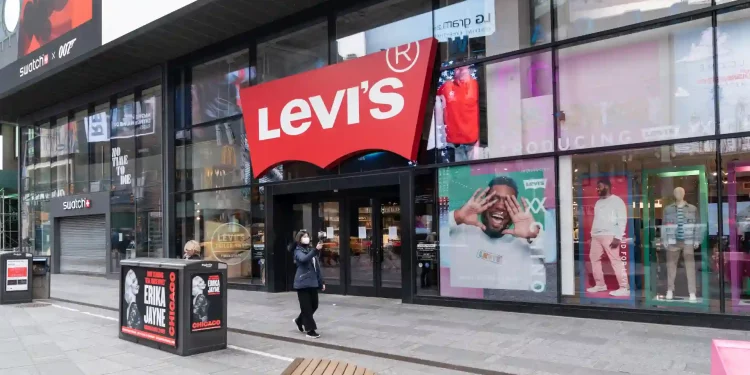Levi Strauss last week reported quarterly revenue and earnings that came in above Wall Street expectations, as the clothing business known for its denim said that it profited from Americans opting for more relaxed dress codes.
The San Francisco Company increased its quarterly dividend and stood by its leadership for the year. The shares progressed by about 4 percent at USD 17.08 in after-hours trading.
In the quarter ended May 29,2022, the Levi Strauss total revenue increased 15 percent to USD 1.47 billion, above analysts’ expectation of USD 1.43 billion, according to IBES data from Refinitiv.
Levi’s also reaffirmed its revenue and profit forecasts for 2022 and accelerated its quarterly dividend by 20 percent to 12 cents per share.
The net income dropped by 23 percent, as the denim maker recorded USD 60 million in charges related to the suspension of its operations in Russia.
The 169-year-old company earned 29 cents per share, in comparison with the estimates of 23 cents.
Levi Strauss said that its higher revenue in the quarter was powered by both extensive and stronger direct-to-consumer sales. It also stated that the digital revenue represented 3 percent increase globally and accounted for 20 percent of sales in the quarter.
The President and Chief Executive Officer of Levi Strauss and Co., Chip Bergh stated that jeans are now significantly more accepted in the office.
Bergh said that the retailer has tracked mid-single-digit declines from a year ago at its two value denim brands, which sell at Walmart, Amazon and Target which adds up to a small percentage of the company’s total business.
He further added that there’s some evidence that among the more value-conscious consumers, the lower-income consumer is starting to feel the congestion and are starting to make some choices.
Bergh said that the declines were more than offset by the company’s core business.
Levi’s reaffirmed its 2022 guidance for net revenue to increase by 11 percent to 13 percent compared to 2021
Sales in the Americas grew by 17 percent, in Europe by 3 percent and 16 percent in Asia compared to the previous financial year. Levi’s other brands-Dockers and Beyond Yoga, witnessed an increase of 56 percent compared to 2021.
The company’s general, selling and administrative expenses stood at USD 779 million in the quarter, higher than the USD 644 million the previous year. The company accredited the increase to the conflict in Ukraine.
The company reported a net income of USD 49.7 million for the quarter, or 12 cents a share, in contrast to USD 64.7 million, or 16 cents a share, in 2021. On an adjusted basis, the company said it earned 29 cents a share in the most recent quarter, which was more than the 23 cents per share as Wall Street anticipated.
For the whole year, the company stood by its guidance for income to develop 11 percent to 13 percent. It expects adjusted earnings of USD 1.50 to USD 1.56 per share.
The firm ramped its quarterly dividend to 12 cents a share, up from 10 cents a share.
Levi’s chief financial officer, Harmit Singh said that the company decided to reaffirm its fiscal 2022 outlook but to increase its dividend given the lingering effects of the war overseas, the potential slowdown of the value-seeking consumer, continued currency changes and Covid lockdowns in China.
About Levi Strauss
Levi’s was founded in 1853, it opened as a wholesale dry goods business in San Francisco that became known as Levi Strauss & Co. The company recognised a need for work pants that could hold up under rougher conditions, and Jacob Davis, a tailor, created the first jean. The first product line assigned by the lot number 501 was created in 1890.
Levi’s is now one of the world’s largest brand-name apparel companies and a global leader in jeans wear. They design and market jeans, casual wear and related accessories for men, women, and children under the Levi’s, Dockers, Signature by Levi Strauss & Co. and Denizen brands.
Its products are sold in more than 110 countries globally through a combination of chain retailers, online sites, department stores, and a global footprint of approximately 3,000 retail stores and shop-in-shops.

















